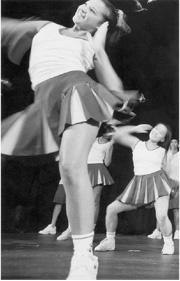FROM THE OUTSET, a group of women in fluttery miniskirts pirouette and leap across a town square. Men in matching pastel and ecru outfits skip out of large trucks. All are wearing white booties that reflect the white-washed buildings in the background. The sky is sunny and the scrubbed-clean dancers—who are really workers—continue their joyous, choreographed bounce as they unload equipment and set up for a fair. Is this what Marx and Lenin had in mind when they dreamed up their workers’ paradise?
The Young Girls of Rochefort
directed by Jacques Demy
starring Catherine Deneuve, Francoise
Dorleac, Gene Kelly
Egyptian Theater, December 1117
Unlike Jacques Demy’s previous musical, The Umbrellas of Cherbourg (1964), which had a surprisingly dark storyline underneath its cotton-candy setting, The Young Girls of Rochefort (first released in 1967) is pure froth. Catherine Deneuve and Francoise Dorleac play musically inclined sisters who long to get out of provincial Rochefort and find fame and marriage in Paris. There’s never any doubt that they’ll get what they want, in the form of a young painter (Jacques Perrin) whose picture of the “feminine ideal” uncannily resembles Deneuve, and of an American musician played by Gene Kelly, whose singing in French is nearly as nimble as his footwork.
Demy styled The Young Girls as an homage to the 1950s Hollywood musicals of Vincente Minnelli. But as the title would suggest, it’s really an excuse to showcase a bevy of lovely 22-year-old women. It’s best to ignore the predictable story and watch this as a set of moving pictures propelled by color, makeup, fashion, and great legs. Even the waitress at the cafe shines beneath her apron.
Demy’s love affair with color was practically obsessive. Just as he had repainted sections of Cherbourg so that The Umbrellas would be much more vivid and color-coordinated than in real life, he painted everything in Rochefort—including hundreds of window shutters—pink, blue, and white. Deneuve and Dorleac complement each other perfectly. Deneuve is blond; Dorleac, a redhead; Deneuve wears a white dress with pink trim; Dorleac a white dress with yellow trim. Both wear big, festive hats wide as parasols that match the shades of their shoes and purses. It’s all frill upon frill, an over-the-top fabrication that depicts romance as pure fairy tale.
It tends toward the overbearing, too. In one scene, the contrast between a lilac-shifted Dorleac and a group of darkly habited nuns is painfully obvious, and painfully trite. It couldn’t be clearer if Demy had verbalized it: Be colorful, be romantic, be women.






